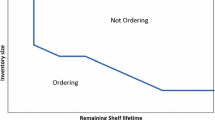Abstract
We consider an inventory system for perishable items in which the arrival times of the items to be stored and the ones of the demands for those items form independent Poisson processes. The shelf lifetime of every item is finite and deterministic. Every demand is for a single item and is satisfied by one of the items on the shelf, if available. A demand remains unsatisfied if it arrives at an empty shelf. The aim of this paper is to compare two issuing policies: under FIFO (‘first in, first out’) any demand is satisfied by the item with the currently longest shelf life, while under LIFO (‘last in, first out’) always the youngest item on the shelf is assigned first. We determine the long-run net average profit as a function of the system parameters under each of the two policies, taking into account the revenue earned from satisfied demands, the cost of shelf space, penalties for unsatisfied demands, and the purchase cost of incoming items. The analytical results are used in several numerical examples in which the optimal input rate and the maximum expected long-run average profit under FIFO and under LIFO are determined and compared. We also provide a sensitivity analysis of the optimal solution for varying parameter values.
Similar content being viewed by others
References
Abate J, Whitt W (1995) Numerical inversion of Laplace transforms of probability distributions. ORSA J Comput 7:36–43
Asmussen S (2003) Applied probability and queues, 2nd edn. Springer, New York
Balcioglu B, Kopach R, Carter M (2008) Tutorial on constructing a red blood cell inventory management system with two demand rates. Eur J Oper Res 185:1051–1059
Bar-Lev S, Perry D, Stadje W (2005) Control policies for inventory systems with perishable items. Probab Eng Inf Sci 19:309–326
Bazaraa MS, Shetty CM (1979) Nonlinear programming: theory and algorithms. Wiley, New York
Berk E, Gürler Ü (2008) The (Q,r) inventory model for perishables with positive lead times and non-negligible ordering costs. Oper Res 56:1238–1246
Berman O, Sapna KP (2002) Optimal service rates of a service facility with perishable inventory systems. Nav Res Logist 49:778–789
Deniz B, Scheller-Wolf A, Karaesman I (2009) Managing inventories of perishable goods: the effect of substitution. Working paper, Tepper School of Business, Carnegie Mellon University
Karaesman I, Scheller-Wolf A, Deniz B (2009) Managing perishable and aging inventories: review and future research directions. In: Kempf K, Keskinocak P, Uzsoy R (eds) Handbook of production planning. Kluwer international series in operations research and management science. Kluwer Academic, Norwell (in press)
Kao EPC (1997) An introduction to stochastic processes. Duxbury, Belmont
Kaspi H, Perry D (1983) Inventory systems of perishable commodities. Adv Appl Probab 5:674–685
Nahmias S (1982) Perishable inventory: a review. Oper Res 30:680–708
Nahmias S, Perry D, Stadje W (2004a) Actuarial valuation of perishable inventory systems. Probab Eng Inf Sci 18:219–232
Nahmias S, Perry D, Stadje W (2004b) Perishable inventory systems with variable input and demand rates. Math Methods Oper Res 60:155–162
Perry D, Stadje W (2000) An inventory system for perishable items with by-products. Math Methods Oper Res 51:287–300
Perry D, Stadje W (2001) Disasters in a Markovian inventory system for perishable items. Adv Appl Probab 33:61–75
Tekin E, Gürler Ü, Berk E (2001) Age-based vs. stock level control policies for a perishable inventory system. European J Oper Res 134:309–329
Author information
Authors and Affiliations
Corresponding author
Rights and permissions
About this article
Cite this article
Parlar, M., Perry, D. & Stadje, W. FIFO Versus LIFO Issuing Policies for Stochastic Perishable Inventory Systems. Methodol Comput Appl Probab 13, 405–417 (2011). https://doi.org/10.1007/s11009-009-9162-2
Received:
Revised:
Accepted:
Published:
Issue Date:
DOI: https://doi.org/10.1007/s11009-009-9162-2




